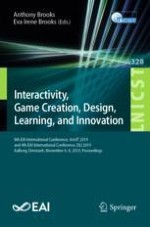2020 | Buch
Interactivity, Game Creation, Design, Learning, and Innovation
8th EAI International Conference, ArtsIT 2019, and 4th EAI International Conference, DLI 2019, Aalborg, Denmark, November 6–8, 2019, Proceedings
herausgegeben von: Anthony Brooks, Eva Irene Brooks
Verlag: Springer International Publishing
Buchreihe : Lecture Notes of the Institute for Computer Sciences, Social Informatics and Telecommunications Engineering
